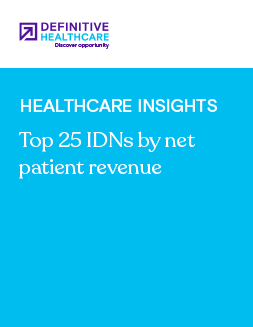Healthcare Insights
How many IDNs are in the U.S.?
The rise of integrated delivery networks (IDNs) is a defining trend in U.S. healthcare. These powerful organizations bring together a diverse network of healthcare facilities and providers–hospitals, physician groups, and clinics–under one umbrella.
This integrated approach aims to streamline care delivery by providing patients with a seamless experience across a broad spectrum of services, from routine checkups to complex surgical care.
As of July 2025, Definitive Healthcare tracked over 900 active IDNs in the U.S. Their distribution varies by state, with some states boasting nearly 100 headquartered IDNs, while others have only a handful.
Using Definitive Healthcare’s HospitalView data, we ranked the U.S. states where the most IDNs are headquartered as of July 2025. Data on these systems is updated daily and based on proprietary research.
| Rank | State | IDN count | Explore dataset |
|---|---|---|---|
| 1 | California | 79 | Explore |
| 1 | Texas | 79 | Explore |
| 3 | New York | 45 | Explore |
| 4 | Florida | 44 | Explore |
| 5 | Pennsylvania | 38 | Explore |
| 5 | Tennessee | 38 | Explore |
| 7 | Ohio | 34 | Explore |
| 8 | Georgia | 31 | Explore |
| 9 | Illinois | 30 | Explore |
| 9 | Louisianna | 30 | Explore |
Fig. 1. Data is from the Definitive Healthcare HospitalView product. Data accessed July 2025.
Which states have the most health systems/IDNs?
Texas and California are tied for the most IDN headquarters in the country, with 79 each. Texas has a total population of 30 million people and is one of the largest states in the country by both size and population. It is also home to some of the largest IDNs in the country, including Tenet Healthcare, Baylor Scott & White, and Steward Healthcare System.
California, the most populous state in the U.S., is also home to 79 IDN headquarters. Major IDNs headquartered in the state include Dignity Health, Prime Healthcare Services, and Kaiser Permanente.
New York takes the third spot with 45 IDNs. Like California and Texas, New York's large population might explain the significant number of IDNs headquartered there. Some of the most notable IDNs headquartered there include Northwell Health, New York-Presbyterian Healthcare System, and Mount Sinai Health System.
| Rank | State | IDN count | Explore dataset |
|---|---|---|---|
| 1 | Vermont | 2 | Explore |
| 2 | Delaware | 3 | Explore |
| 2 | North Dakota | 3 | Explore |
| 2 | Wyoming | 3 | Explore |
| 5 | Rhode Island | 4 | Explore |
| 5 | South Dakota | 4 | Explore |
| 7 | Alaska | 5 | Explore |
| 7 | Idaho | 5 | Explore |
| 7 | Maine | 5 | Explore |
| 7 | Nevada | 5 | Explore |
Fig. 2. Data is from Definitive Healthcare’s HospitalView database. Data accessed in July 2025.
Which states have the fewest IDNs?
Vermont ranks lowest in the number of headquartered integrated delivery networks (IDNs), with only two: the University of Vermont Health Network and North Star Health. This limited number likely reflects the state's small population and largely rural landscape, which may reduce the need for a complex healthcare infrastructure.
In second place, three states—Delaware, North Dakota, and Wyoming—each have three IDNs. These states also have relatively small populations and vast geographic areas, factors that may contribute to the limited number of IDNs.
Rhode Island and South Dakota share the third spot, with four IDNs each. Both states are either geographically small or sparsely populated, suggesting a potentially lower demand for large-scale healthcare systems.
It's important to consider that "fewest" is relative. Even with only two or three IDNs, these states might still have adequate healthcare coverage for their residents, or have population density that’s situated close to bordering states, with residents traveling to the border state for their care.
State-by-state differences in hospital consolidation
Our data also reveals variation in how integrated hospitals are into health systems across the United States—a key indicator of healthcare market consolidation.
In states like Delaware (94.7%), Rhode Island (94.4%), and Hawaii (93.5%), nearly all hospitals are part of a health system, underscoring the dominance of large networks in care delivery.
| Rank | State | % of hospitals in IDNs | Explore dataset |
|---|---|---|---|
| 1 | Delaware | 94.7% | Explore |
| 2 | Rhode Island | 94.4% | Explore |
| 3 | Hawaii | 93.5% | Explore |
| 4 | Florida | 93.2% | Explore |
| 5 | Tennessee | 93.2% | Explore |
| 6 | Virginia | 93.0% | Explore |
| 7 | Washington D.C. | 92.9% | Explore |
| 8 | South Carolina | 92.7% | Explore |
| 9 | North Carolina | 92.0% | Explore |
| 10 | West Virginia | 90.7% | Explore |
Fig. 3. This table ranks states by the percentage of hospitals that are part of an IDN, meaning these hospitals roll up under larger health systems. Data is from Definitive Healthcare’s HospitalView database. Data accessed July 2025.
Larger states such as Florida and Tennessee also show high rates of hospital consolidation, each at 93.2%, suggesting that consolidation is not just a small-state phenomenon. Even in sprawling markets like Texas (83.2%) and California (82.2%), most hospitals belong to a larger system.
Conversely, states like Vermont (35.3%), Nebraska (40.6%), and Wyoming (48.6%) remain less consolidated, with a significant number of independent hospitals without a parent network.
| Rank | State | % of hospitals in IDNs | Explore dataset |
|---|---|---|---|
| 1 | Vermont | 35.3% | Explore |
| 2 | Nebraska | 40.6% | Explore |
| 3 | Wyoming | 48.6% | Explore |
| 4 | North Dakota | 58.9% | Explore |
| 5 | Montana | 59.7% | Explore |
| 6 | Kansas | 63.5% | Explore |
| 7 | Idaho | 64.9% | Explore |
| 8 | Washington | 68.1% | Explore |
| 9 | Louisiana | 69.8% | Explore |
| 10 | Mississippi | 71.3% | Explore |
Fig. 4. This table ranks states by the percentage of hospitals that are part of an IDN, meaning these hospitals roll up under larger health systems. Data is from Definitive Healthcare’s HospitalView database. Data accessed July 2025.
For healthcare vendors, stakeholders, and investors, this data underscores the importance of understanding local market structures, especially when navigating procurement cycles, partnership strategies, and market entry across highly consolidated versus more fragmented landscapes.
What is the difference between an IDN and a health system?
While IDNs are considered health systems, not all health systems may be classified as IDNs. An IDN is a form of health system, but traditional health systems differ in that they are typically independent organizations that work together through contractual agreements and share financial and medical responsibilities rather than through direct ownership or control.
An IDN, on the other hand, oversees all the facilities, physicians, hospitals, technologies, and administrations under them. Within an IDN, there is often a high level of integration and coordination among facilities, physicians, and other providers. IDNs may have agreements with specific health plans and may even own a health insurance entity, allowing for greater control over care delivery and payment.
Why are IDNs important to healthcare?
Integrated delivery networks are important to healthcare for several reasons. IDNs bring together various healthcare providers and organizations under one umbrella, facilitating better coordination of care for patients. This coordination can help patients receive seamless transitions between different levels of care and can reduce the likelihood of medical errors or duplicative services.
By integrating diverse healthcare services and providers, IDNs can also standardize clinical practices, implement evidence-based guidelines, and promote best practices across the network. This standardization can promote consistent care for patients regardless of where they receive treatment within the network.
IDNs can also pool resources, including medical equipment, technology, and personnel, across their network of facilities. This may allow for better allocation of resources to meet patient needs, reduced waste, and economies of scale.
IDNs, particularly larger ones, have increased negotiating power with payors, pharmaceutical companies, medical device manufacturers, and other healthcare stakeholders. This leverage can allow them to secure favorable contracts, pricing arrangements, and reimbursement rates.
Finally, IDNs offer a continuum of care that spans primary care, specialty care, acute care, post-acute care, and sometimes even health insurance coverage. This comprehensive approach means patients can usually receive care at every stage of life, from infancy to old age, without leaving the IDN.
Learn more
Healthcare Insights are developed with healthcare commercial intelligence from the Definitive Healthcare platform. Want even more insights? Start a free trial now and get access to the latest healthcare commercial intelligence on hospitals, physicians, and other healthcare providers.


